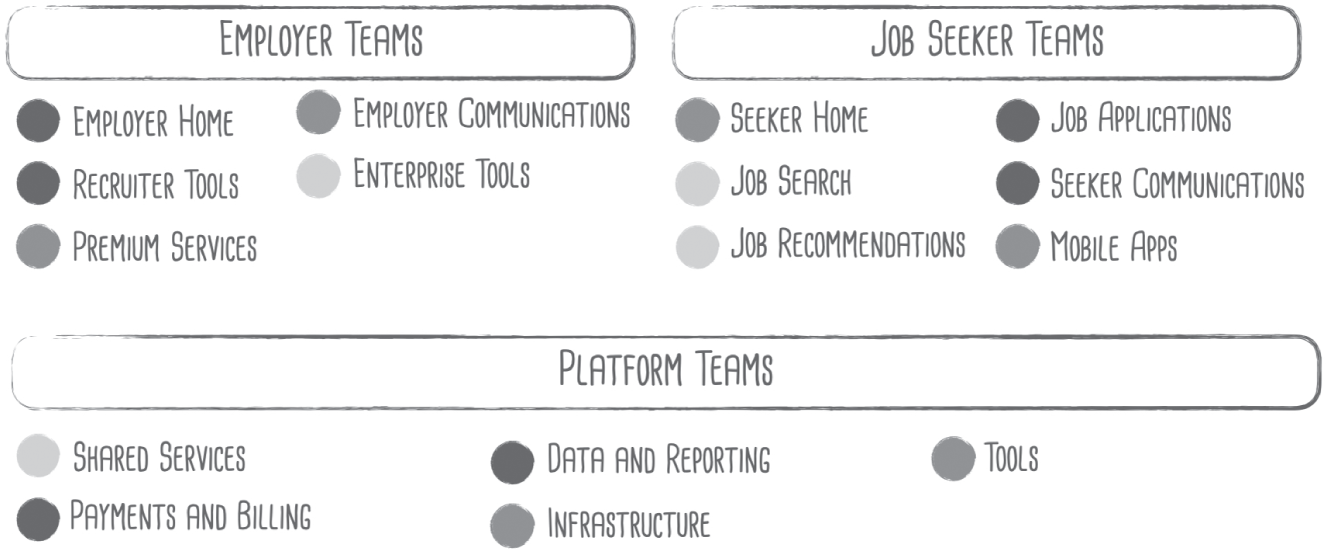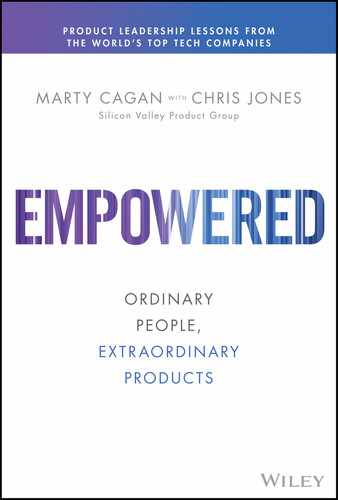CHAPTER 65
Team Topology
At the beginning of the quarter, the company had 16 product teams comprised of 60 engineers, 12 product managers,1 10 product designers, 2 user researchers, and 3 data analysts.

There are 2 directors of product management (one for employer and one for seeker) and 1 director of user experience design (all three reporting to the CPO), along with 3 directors of engineering (one each for employer, seeker, and platform—all reporting to the CTO).
Team Topology Overview
They have two types of experience teams—those focused on employers and those focused on job seekers—designed to align with the two main types of customers. They also have about a third of their resources devoted to an internal platform that the experience teams are all built upon.

Employer Teams
- Employer Home
- Recruiter Tools
- Premium Services
- Employer Communications
- Enterprise Tools (new team)
Job Seekers Teams
- Seeker Home/Personalization
- Job Search
- Job Recommendations
- Job Applications
- Seeker Communications
- Mobile Apps
Platform Teams
- Shared Services
- Payments and Billing
- Data and Reporting
- Infrastructure
- Tools
Employer Organization
The Employer organization is there to serve the needs of the hiring managers and HR departments. They currently offer a freemium service where the first job posting is free, but to get additional postings—or premium services including featured jobs—there are listing and promotional fees.
These are the actual product teams and what each is responsible for:2
- Employer Home—This team is responsible for the dashboard for employers showing current job postings and applications in various states of review. This team also provides the ability to post a job, and to ensure that job is visible in organic search results (SEO).
- Recruiter Tools—For employers that have HR departments, there are advanced capabilities for loading and managing large numbers of open jobs and managing the flow of applications, interviews, and decisions. This team also provides ways to search the marketplace for seekers with specific attributes, and then allowing the recruiter to reach out to these job seekers rather than wait for them to apply.
- Premium Services—Employers have several optional services that are all designed to help them fill their open positions more quickly or generate an increased flow of applications. These premium services include having the jobs included in emails, featured jobs, and so on.
- Employer Communications—This team manages the several forms of ongoing communications with employers, especially having to do with the status of their open jobs, including emails, text, and notifications. This is both transactional (information about a specific job) and marketing (encouraging the employer to post additional jobs). This team is also responsible for online recruiting of new employer customers looking to post jobs (SEO and SEM).
- Enterprise Tools (newly formed team)—As the company moves toward helping large enterprises with their recruiting, they believe they need several enterprise‐specific capabilities, such as integration with large‐scale applicant‐tracking systems (ATS). This team is focused on identifying what is necessary to satisfy enterprise employers and delivering those capabilities.3
Job Seeker Organization
The Job Seeker organization is focused on helping people who are looking for a job to find a job.
- Seeker Home—This team provides the core experience for the job seeker on both the web and native mobile apps. This includes a dashboard of jobs the seeker is currently tracking, the status of applications, and recommendations for other jobs that may be a fit.
- Job Search—This team provides the services that allow a job seeker to search the marketplace based on job attributes.
- Job Recommendations—This team utilizes the data that has been collected in terms of searches and the seeker profile, and generates recommended jobs.
- Job Applications—This team allows a seeker to apply for a specific job—collecting the information that has already been provided and combining it with any job‐specific information that may be needed for that particular job.
- Seeker Communications—This team handles the various forms of communication with job seekers including email, text, and notifications. This is both transactional (status of a job application) as well as marketing (encouraging the seeker to return and apply for additional jobs). This team is also responsible for online recruiting of new job seekers (SEM and SEO).
- Mobile Apps—This team provides job seekers with a native mobile experience for both iOS and Android devices. This team works very closely with the Seeker Home team as they try to keep the web experience and the mobile experiences comparable.4
Platform Organization
The Platform organization exists to help the Employer and Job Seeker teams be more efficient in serving their respective customers. By providing a reliable platform, the experience teams can focus on innovating in terms of value for their users and customers and not have to worry about the lower‐level services.
- Shared Services—Whenever teams realize that there are potentially duplicate efforts going on across different teams, the Shared Services team works to provide a single solution that meets the needs of the various teams. This includes services such as authentication, preference management, and dozens of other similar capabilities. The Shared Services team is there to help make the Employer and Job Seeker teams more productive.
- Payments and Billing—This team handles all financial transactions including recurring payments, discounts, promotions, and the various payment methods. There is a significant amount of complexity managed by this small, but very experienced team, but the benefit is that the other teams don't have to understand this complexity in order to use the services.
- Data and Reporting—Many parts of the company depend on reporting of the marketplace activity, starting with the product teams, but also including finance, marketing, sales, and company leadership. This team provides the reporting infrastructure that is fed to the employer and seeker dashboards, as well as enabling self‐service reporting by the rest of the company.
- Infrastructure—The Infrastructure team is responsible for ensuring that the technology infrastructure is able to meet the needs of the business. As such, they have taken the lead on major technical debt issues as well as assisting the engineers in the product teams with overcoming scale and performance challenges.
- Tools—The Tools team is there to help all the product teams—Employer, Job Seeker, and Platform—with tools and services to help them be more productive and generate more‐reliable systems. This includes site‐monitoring services, test‐and‐release automation (DevOps) tools, and miscellaneous productivity and team collaboration tools.
Notes
- 1 You'll note that they only have 12 product managers but 16 product teams. This will be explained below.
- 2 Just to be clear, the “product” is the jobs marketplace, and each of these 16 product teams is responsible for a subset of this larger product.
- 3 This team ended up embedding a product marketing person full‐time on the team because there was so much critical work to be done in terms of developing the reference customers, the go‐to‐market considerations, and starting to understand and prepare the sales‐enablement materials. This turned out to be very important and is a great practice for any product where messaging more specifically to a target segment or a new business is important. The book LOVED goes into more depth on scenarios where product marketing is particularly important in unpacking what's necessary for go‐to‐market success for a product in situations like these.
- 4 When this work was going on, many companies had a special, dedicated “native mobile apps” team because so few engineers had at that point been trained on iOS and Android native app development. Within a year or so, this work moved into the other seeker teams—especially the Seeker Home team—which is, in general, a much better solution.
